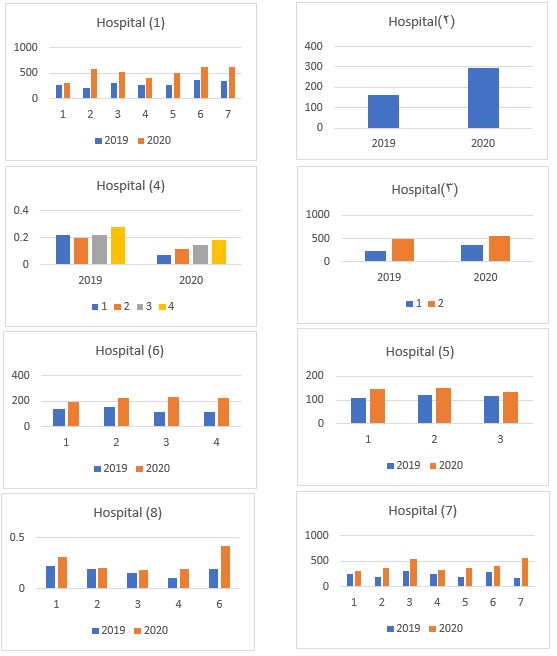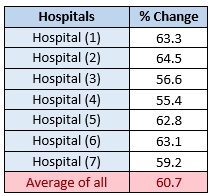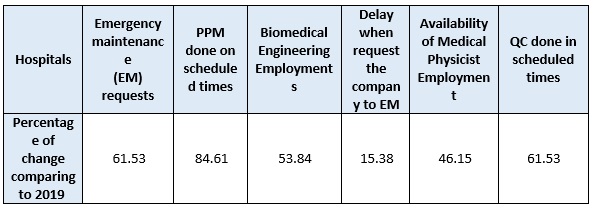Study of the impact of COVID-19 pandemic on radiology departments
Study of the impact of COVID-19 pandemic on radiology departments
Since December 2019 the world fighting COVID-19 virus. The virus discovered first time in Wuhan, China, then continues spreading whole of the world and completely effect many life aspects. The radiology departments are one of the most departments in the hospitals that has an important essential role to overcome the pandemic. As following-up the impact of COVID-19 virus on the lung, general x-ray devices and computed tomography used as a tool to detect COVID-19 symptoms in the lung.
The increase of COVID-19 cases increases the need to use of medical imaging-devices, which rise the need to measure the effect of COVID-19 pandemic on the safe use of the radiation imaging devices in the healthcare facilities in the Kingdom.
Increase the use of ionizing radiation medical imaging devices during the pandemic may increase the radiation exposure to the staff inside the healthcare facility.
The study was devoted to the hospitals that participating to provide services to COVID-19 patients in different administrative areas in the Kingdom of Saudi Arabia during the period from January to July 2020.
There are hospitals from central, eastern, and western regions and a hospital from northern board region are participated in the study. Some of the participating hospitals are private and other hospitals are government hospitals. The following questions sent to the participating hospitals via emails:
1. Personal Radiation dosimeters readings, the First and second quarters for radiologist who working on Computed Tomography, general and portable X-Ray during the pandemic (January to July 2020). Also, the Personal Radiation dosimeters readings for the same persons at same period in 2019.
2. The number of chest x-ray requests by using CT and general X-rays during the pandemic, and the same information on the same period in 2019.
3. Yes or no questions:
• Does the Periodic Preventive Maintenance (PPM) for the Computed Tomography, General and portable X-Ray were done at the scheduled times?
• Is the PPM done by biomedical engineers who are working at the same hospital
• Compared to2019, is there a delay in the response from maintenance companies’ when requesting a maintenance service?
• Dose the quality control tests for the CT and X-ray devices were done at their scheduled times during the quarantine?
• Dose the quality control test were done by a physicist from the hospital or company
After the data collected, the data were analyzed to find out the effect of the COVID-19 pandemic on the radiology departments.
1- The average of personal radiation dosimeters readings for the first and second quarters for radiologists who working on Computed Tomography, General and portable X-Ray during the pandemic, from January to July 2020 and 2019.

2. The chest X-ray requests during 2019 and 2020.

3. Planed Preventive Maintenance , quality control tests requests, and the availability of biomedical engineering and physicist employees:

1. The average of personal radiation dosimeters readings for the first and second quarters for radiologists who working on Computed Tomography, General and portable X-Ray during the pandemic, from January to July 2020 and 2019.
The data were collected from 7 different hospitals which diverse between private hospitals and MOH hospitals, while, there were difficulties in collecting data from 7 other hospitals due to reading classifications, In addition, some hospitals could not provide their readings for specific quarters which affects the comparison and the calculation of the percentage of change.

2. The changes of the chest X-ray requests between 2019 and 2020:
There were 11 hospitals participating by sharing their data of the Chest X-ray imaging requests.
The hospitals were diverse between MOH hospitals and Private hospitals. While three hospitals failed to share their data as requested because of the absence of the Picture Archiving and Communication System (PACS). The data presented in the following table:

The percentage of change in the chest X-ray imaging requests on the 2019 and 2020 calculated as following:

3. The percentage of change on PPM, QC requests and availability of biomedical engineer and physicist affiliated to the facility presented in the following table:

After the data collected from the participating hospitals, which diversified between private hospitals, and government hospitals. There was an increase by 60% on the personal radiation dosimeters readings for the radiologist who working on computed tomography and X-ray devices compared to 2019. This means that the radiologist exposed to more radiation compared to last year, this increase justified because of the COVID-19 pandemic and the use of computed tomography and X-ray devices to find-out the effect of the virus on the patients instead of other non-ionizing radiation modalities. Despite this increase in exposer to radiologists, it is still less than the permissible annual limit for radiation worker exposure. In addition, when comparing the number of request for chest CT imaging in 2020 and 2019 there was a decrease by 143% in the request on the government hospitals. This could be justified by the protocol of these hospitals to dealing with the pandemic. The government hospitals stop all routine cases and appointments. All efforts on hospitals are concentrated to serve COVID-19 patients, all operators, and daily unnecessary appointments delayed. In another hand, in the private hospitals that participating in the study, the number of chest CT requests number increased by 40% compared to last year. The protocol that followed in the private hospitals when dealing with COVID-19 patients could justify this increment. Which referring the suspected COVED-19 patients to Chest CT imaging rather than the PCR test firstly. In addition, after analyzing the data it’s clear that there is a decrease in the chest x-ray imaging request in both government and private hospitals by 43% and 8% respectively. This decrease due to delay any non-urgent appointments and follow up during the pandemic to reducing the spread of the COVID-19 virus and limit the chest x-ray request to the inpatients to measure their recovery and their response to medication. In another hand, the study shows that 61% of participating hospitals are committed to doing PPM and QC tests on their scheduled times.
While the rest of the hospitals failed to be committed because they do not have their own biomedical engineer and physicist, or the companies that they dealing with are not licensing from the SFDA and do not has a mobility permit during the quarantine period. It should note that the SFDA during the quarantine provides a mobility permit to all the companies that have SFDA licenses.
Summary of findings:
1. Increase the radiation worker exposer to ionizing radiation by 60% compared to the amount of exposure last year. It should note that despite the observed increase, the exposure is still less than the annual limit of the exposure of the radiation workers, which is 20 mSv per year.
2. Increase the chest CT Imaging requests by 40% in private hospitals compared to last year.
3. Decrease the chest CT Imaging requests by 143% comparing with the number of requests last year in MOH hospitals.
4. Decrease the chest X-ray Imaging requests by 43% in private hospitals and by 8% in MOH hospitals compared to last year.
Most of the hospitals that participate in the study are committed to the safe use requirements of the Saudi Food and Drugs Authority even though the pandemic affects the workflow during the quarantine period.
1. Communicate with the relevant competent departments in the Ministry of Health, such as the General Department of Compliance and the General Department of Radiology, and provide them with the results of the study to keep watching the radiation workers dose and assure that their exposure does not exceed the annual permissible limit.
2. Continuing to follow up on the commitment of radiology departments in healthcare facilities to apply the authority requirements and ensure that all detected violations corrected.
3. To re-conduct the study after the end of the pandemic to measure the impact on radiology departments in health facilities.
Continuing the safe use of radiation imaging devices and commitment to the requirements of the Saudi Food and Drug Authority, which ensures the safety of both medical imaging technicians and patients.


